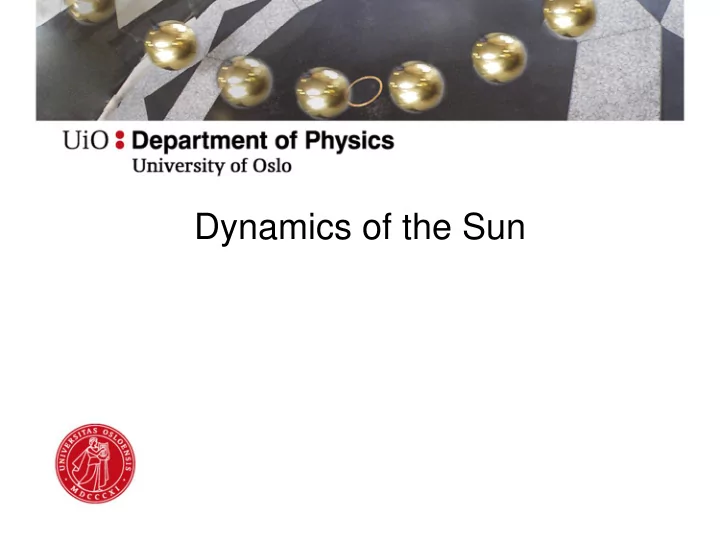

Dynamics of the Sun
Interior structure of the Sun 9/6/2016 2
Some parameters 9/6/2016 3
Solar spectrum 9/6/2016 4
Hertzsprung-Russell diagram • Luminosity vs. surface temperature • Luminosity is surface area times energy flux • Energy flux is proportional T^4 (Stefan-Boltzmann-Law) 𝑀 = 4𝜌𝑆 2 𝜏𝑈 4 • • Source of energy is fusion, i.e., lighter atoms fuse to form heavier elements, which leads to energy release 9/6/2016 5
Interior structure of the Sun 9/6/2016 6
Solar Dynamics Observatory • Satellite carries a Michelson Interferometer • Doppler shift of one spectral line is measured, giving the line-of-sight velocity of the Sun • Blue represents motion toward the observer, red away • Strongest signal is rotation of the Sun, but sun spots show different dynamics 9/6/2016 7
Global helioseismology • Spatial variations of Doppler shift in spectral lines reveals radial motion of solar surface. • Typical amplitude of a single mode: < 20 cm/s • Total velocity of all 10 7 modes: a few 100 m/s • Accuracy of current instruments: better than 1 cm/s • Spatio-temporal properties of oscillations best revealed by 3-D Fourier transforms (2-D space + 1-D time) 9/6/2016 8
Ray paths • Local disturbance creates perturbations that travel through the Sun (p-modes). • Due to changes in background density and temperature, the wave paths are refracted. • Superposition of waves creates interference pattern which can be inverted to learn something about the internal structure of the Sun – or star. 9/6/2016 9
Some solar features 1) Core 2) Radiative zone 3) Convective zone 4) Phtotosphere 5) Chromosphere 6) Corona 7) Sunspot 8) Granulae 9) Prominence 9/6/2016 10
Chromosphere • Region between photosphere and corona • Temperatures between 4,000K and 10,000K • Consists mainly of neutral hydrogen and is hence best observed in the Lyman alpha line in the UV. 9/6/2016 11
Filaments • Filaments are regions which appear darker than the background. • They appear darker because the plasma is colder. • They have chromospheric densities. 9/6/2016 12
Chromosphere/photosphere • Comparisson between the chromosphere (left) and the photosphere (right) of the Sun. • Chromosphere shows prominences/filaments and sunspots. • Photosphere shows granulation and sunspots. 9/6/2016 13
Granules • Granules are about 1000km diameter and last for about 10 minutes. • Between granules you have the intergranular lanes which are made out of colder plasma, hence they appear darker. • Inside the granules the plasma rises with about 1 km/s. 9/6/2016 14
Sunspots 9/6/2016 15
Sunspot • Sunspots have two regions, the dark, inner region called umbra and the only slightly darker region called the penumbra. • The umbra is characterized by relatively cold plasma of about 4000K, and strong magnetic fields (about 1000 times the normal photospheric field) • Typical life times are several days to weeks 9/6/2016 16
Convection associated with sunspot • At the center of teh sunspot (umbra), the magnetic field is nearly vertical. • The plasma is frozen to the magnetic field, so it cannot moves sideways at the surface but just sits there and cools. • The magnetic field is more inclined in the penumbra, allowing some convection movement, hence it is a little warmer than the umbra, but colder than the surrounding. 9/6/2016 17
The inside of a sunspot • Sunspots usually appear in pairs with opposite magnetic polarity. • With the help of spectroscopy you can measure the magnetic field inside the sunspot. 9/6/2016 18
Zeeman effect 9/6/2016 19
Solar magnetogram 9/6/2016 20
Differential rotation 9/6/2016 21
Formation of sunspots • The velocity shear at the radiative zone/convection zone boundary creates the solar magnetic field. • The differential rotation of the convection zone «winds up» the magnetic field lines over time. • At some point, the magnetic field rises through the convection zone (it bubbles up) and breaks through the photosphere, creating a pair of sunspots with opposite polarities. 9/6/2016 22
First sunspot observations • In 1610, shortly after viewing the sun with his new telescope, Galileo Galilei (or was it Thomas Harriot?) made the first European observations of Sunspots. • Christoph Scheiner (1573- 1650), a Jesuit mathematician began his study of spots in 1611 • Scheiner, wished to preserve the perfection of the Sun and the heavens and therefore argued that sunspots were satellites of the Sun. 9/6/2016 23
Butterfly diagram 9/6/2016 24
Solar cycle variations • Not only the number of sunspots varies, but also other solar parameters like • The total irradiance («solar constant») • The number of flares • The amount of electromagnetic radiation emitted in the UHF radio band (at 2800 MHz) 9/6/2016 25
Leading sunspot polarity 9/6/2016 26
22-year cycle • The leading polarity of sunspot pairs changes between solar cycles – known as Hale’s Polarity Law. • The change occurs during solar minimum. • The polar magnetic field of the Sun changes at solar maximum, is hence out of phase with the sunspot magnetic fields. 9/6/2016 27
Change of polar solar magnetic field • The polar magnetic field of the Sun changes at solar maximum • This change is hence out of phase with the sunspot magnetic fields. 1995 2000 9/6/2016 28
Coronal holes 9/6/2016 29
• Coronal mass ejections (CMEs) are balloon-shaped bursts of solar wind rising above the solar corona • Solar plasma is heated to tens of millions of degrees, and electrons, protons, and heavy nuclei are accelerated to near the speed of light. • Each CME releases up to 100 billion kg of plasma, and the speed of the ejection can reach 1000 km/s in some flares. • CMEs are currently the biggest "explosions" in our solar system 9/6/2016 30
Current solar cycle 9/6/2016 31
Recommend
More recommend